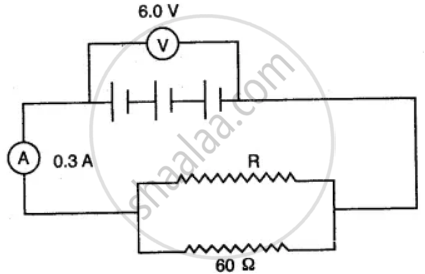Advertisements
Advertisements
Question
Explain, why is the p.d. between the terminals of a storage battery less when it is supplying current than when it is on open circuit. A battery of e.m.f. 10 volts and internal resistance 2.5 ohms has two resistances of 50 ohms each connected to it. Calculate the power dissipated in each resistance
(a) When they are in series,
(b) When they are in parallel.
In each case calculate the power dissipated in the battery.
Solution
In an open circuit no current is drawn from the cell whereas in closed circuit, an amount of energy is spent in the flow of unit positive charge through the electrolyte of the cell. Thus, the p.d. between the terminals of a storage battery is less when it is supplying current.
Given, emf e = 10 V, internal resistance r = 2.5 Ω
Two external resistances R1 = R2 = 50Ω (= R, say)
(a) When R1 and R2 are connected in series, same current flows through each resisto and hence same power is dissipated in each resistor.
Total resistance of the circuit, Rs=R1 + R2 +r = 50 + 50 + 2.5 = 102.5Ω
Current through each resistor = `"e"/"R"_"s" = 10/102.5 = 0.096"A"`
Power dissipated in each resistor =I2R (0.096)2 (50) = 0.46 watt
(b) When R1 and R2 are connected in parallel, voltage across each resistor is same and hence same power is dissipated in each resistor.
Total resistance of the circuit Rp = `(1/"R"_1 + 1/"R"_2)^-1 + r = 25 + 2.5 = 27.5 Omega`
Current through the circuit, I= `"e"/"R"_"p" = 10/27.5 = 0.36 "A"`
Voltage across each resistor, V = e -Ir= 10 - ( 0.36 x 2.5) = 9.1V
Power dissipated in each resistor P = `"V"^2/"R" = (9.1)^2/50 = 4140.5 "watt"`
APPEARS IN
RELATED QUESTIONS
Differentiate between resistances in series and parallel.
Complete the following :-
(c)

Show how you would connect two 4 ohm resistors to produce a combined resistance of (a) 2 ohms (b) 8 ohms.
You are given three resistances of 1, 2 and 3 ohms. Shows by diagrams, how with the help of these resistances you can get:
(i) 6 Ω
(ii) `6/1` Ω
(iii) 1.5 Ω
How will you connect three resistors of resistances 2 Ω, 3 Ω, and 6 Ω to obtain a total resistance of 4 Ω, and 1 Ω?
If current flows through two lamps arranged:
(a) in series,
(b) in parallel,
and the filament of one lamps breaks, what happens to the other lamp? Explain your answer.
Solve the following question:
In an electric circuit, two resistors of 12 0 each are joined in parallel to a 6 V battery. Find the current drawn from the battery.
In the figure below, the ammeter A reads 0.3 A. Calculate:
(i) the total resistance of the circuit
(ii) the value of R
(iii) the current flowing through R.

Four resistors each of resistance 5 Ω are connected in parallel. What is the effective resistance?
